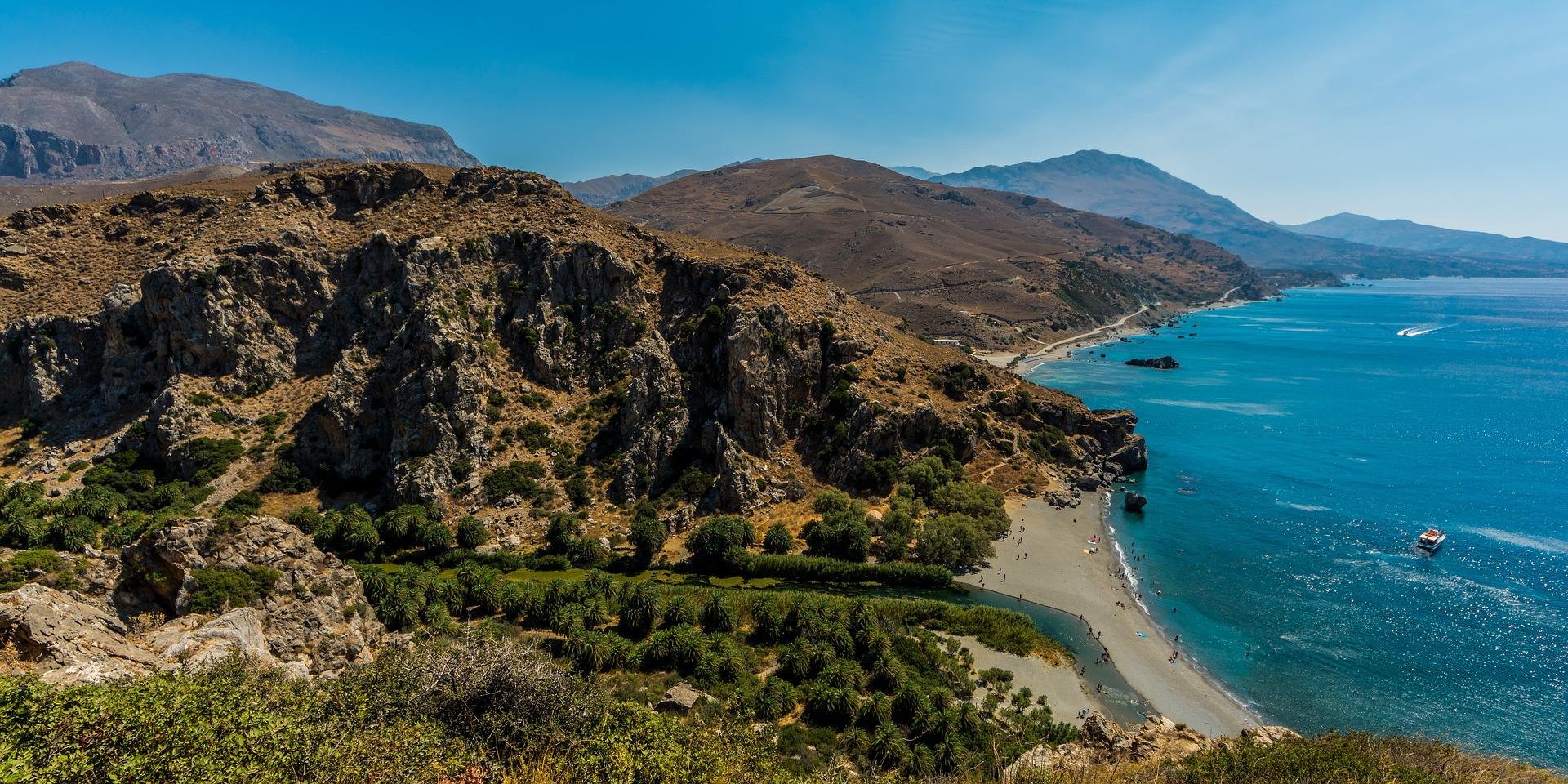
CRETE 7 days
Crete, Greece's largest island is known for its varied terrain, which features fine-sand beaches at Elafonisi,fertile coastal plains, rugged mountains and busy metropolitan towns to peaceful hillside villages. Crete is approximately 260 km (156 mi.) long and 60 km (36 mi.) wide.
The best towns on Crete:
Chania Town is the most beautiful town in Crete. The Old Town of Chania, with the evident Medieval style, is a wonderful place to walk around, lined up with elegant Venetian mansions and restaurants.
The town of Rethymno, located 70 km east of Chania is another great town on the island. A walk around town will bring you to old churches, elegant mansions, interesting museums, and a picturesque port. On the hill above Rethymno is a Venetian Fortress offering a fantastic view to the sea and the town.
DAY 1 and 2
Arrive in Crete at Chania or Heraklion airport.
Transfer to your hotel in Chania. Relax rest of day.
Public transport is not great on the island, and you'll need something to get to all the awesome beaches and towns. A rental car is the best way to get around.
Why stay in Chania ?
Explore Chania - known for its 14th-century Venetian harbor, narrow streets and waterfront restaurants.
Walk along the Venetian magnificent harbor, “ do not miss “ taking a stroll on the seawall to the lighthouse.
Visit the villages near Chania, where the old men talk, argue and play cards at their local kafeneio (cafe) or just simply find a stretch of beach.
Chania points of interest:
Travel Guide: DK Eyewitness Top 10 Crete.
Travel Adaptors: Type C and Type F.
Overnight: Chania (a good base for your entire stay on Crete)
Distance: Heraklion airport —> Chania, 2 hrs./ 140 km.
ADD AN EXTRA BEACH DAY <Preveli Beach>
🏖️ Preveli Beach sits on the South Coast of Crete. One of the most uniquely beaches in Crete. The scenic beach mixes in a clear river, a gorge walk and a freshwater lagoon. An 1 hr 45 min drive from Chania.
DAY 3
Spend the day discovering some of Crete’s most stunning beaches.
Elafoniss beach - it is Crete’s top beach. On Crete's southwest coast, this stunning beach is a 2-hour drive from Chania (73 km).
The watercolors are amazing - the sand takes on pink hues in certain light and the sea is turquoise blue. The water is generally quite shallow and safe for children.
Facilities available: beach bars, umbrellas, toilets,
Balos beach at the northwest tip of the island is quickly following in the footsteps of Elafonisi.
Go early or join the first boat to avoid crowds and get better lighting for photos.
No shade on the beach – bring an umbrella or hat.
Take a boat cruise from the Kissamos Port.
Overnight: Chania
Distance:
Chania —> Balos beach, 90 minutes one way.
Chania —> Elafoniss beach, 2 hrs one way.
DAY 4
Samaria Gorge Trek:
Crete's well-known mountains are cut by deep gorges. The longest is the 17-km (10 mile) Samaria - one of Europe’s most popular treks. It’s a challenging hike, which can be done independently or as part of an organized excursion. The path is steep and uneven at first, descending through dense pinewoods but very manageable.
It is an all-day adventure. Don’t forget sunscreen and snacks.
OPEN from beginning of May through the end of October.
Book the Gorge tour with your hotel (it’s your best option).
A organized tour will pick up and drop you off at your hotel. (Reserve tour at least 1 day in advance).
At sunrise, the organized tour /public bus travels from Chania to the trail entrance-at the village of Omalos.
The gravel trail winds its way 17-km (10 miles) between some 1,600-foot vertical walls down to Agia Roumeli, a seaside village. There you will find a black sand beach where you can rest or take a swim before taking the ferry back.
The only way out of Agia Roumeli is by taking the ferry to Hora Sfakion, where either a bus or taxi brings you back to Chania.
-
This majestic gorge is considered one of the great attractions of Crete. Just be aware it is a long 5 to 7 hours walk on rough terrain so you will need to have a certain degree of fitness, good shoes and walking experience in order to enjoy it. The trek is downhill and then flat.
The most common way to "do" the gorge is to book an organized tour. Best option is to book tour with your hotel.
You will be picked up from and returned to your hotel. This does not mean that you need to walk in a group. Everyone walks at their own pace and meets in Agia Roumeli. Here a ferry brings you to Hora Sfakion and then a bus or taxi takes you back to Chania.
These tours are not very expensive and can be booked locally, often directly at the hotel where you are staying. It is a good idea to book one (1) day in advance.
PLEASE BE AWARE: open from early May to end of October each year.
Other considerations:
The path is maintained and is substantially better than "normal" mountain paths in Crete.
There are wardens along the way (in radio contact with each other) who will help you in case of trouble or injury.
There are well-maintained springs on the way so that you do not have to carry much water.
There are toilets in several places and plenty of rubbish bins.
Wear good walking shoes and bring sunscreen.
Overnight: Chania
Distance:
—Chania —> Omalos Gorge entrance. 1 hr.
—Agia Roumeli —> Hora Sfakion, by Ferry, 1 hr.
—Hora Sfakion (bus ride) —> Chania. 1.5 hrs.
DAY 5
Discover Rethymno’s Old Town and wander the narrow alleys.
Here are examples of Venetian Renaissance architecture along with a taste of Turkish influence spread throughout the city.
Explore the picturesque town of Spili, a small detour south of Rethymno, go for a coffee at one of the village’s many cafes. The streets are paved with cobblestones and livestock roam the fields. Strolling through the narrow streets of Spili, you'll encounter traditional stone houses adorned with colorful flowers and charming courtyards.
Overnight: Chania
Distance:
Chania —> Rethymno: 1 hour. one way.
Spili —> Rethymno: 35 min. one way.
-
<map>
The south coast of Crete is mainly a region of tranquility and authentic Cretan culture.
The south coast of Crete is quite long. A drive from west to east can take more than 4 hours.
1. ~ Chania to Sfakia - 1.5 hour drive. (without stops)
2. ~ Imbros Gorge - is an 11 km long canyon located before Hora Sfakion(Skakia) in southern Crete.
The gorge of Imbros is the second most popular gorge for walkers in Crete after the gorge of Samaria.
The main reasons for this are that:
*It is much easier to walk than Samaria: walking distance is 8 km, total descent is around 600m and the average walking time is about 2.5 hours.
* The path is generally easier underfoot.
*This is the sort of walk that you could easily walk with children.
* It also would not need to take a whole long day
3. ~ Chania to Frangokastello - 2 hr drive - without stops
Frangokastello - Frangokastello is in the area of Sfakia, on the south coast of west Crete, 13 kilometres east of Chora Sfakion .
Frangokastello is a small seaside village. It is famous for its Venetian castle of the same name, which is preserved in very good condition.
About 300 metres east of the castle is one of the most BEAUTIFUL BEACHES in Crete, known as “Orthi Ammos” (“Standing Sand”), named after the sand dunes you have to scramble down to reach the water. The sea is crystal-clear and the bottom slopes down very gently.
Watch video: Hora Sfakion.
DAY 6
Take a scenic drive fro Chania to the southern coast.
Journey to Askyfou Plateau and then descend to Hora Sfakion, driving alongside the imposing sheer cliffs of the Imbros Gorge. Shortly after you will see the blue waters of the Libyan Sea.
Stop at Hóra Sfakíon (Sfakia Village). The picturesque seafront village is known for its local cuisine, excellent cafes and fish taverns.
Continue to Frangokastello (south coast). Located 13 km from Hora Sfakion.
Fragokastello is a popular beach in southwest Crete, due to the historical Venetian castle on the beach.
Distance: Chania to Hóra Sfakíon - 1.5 hr drive.
DAY 7
Depart Crete to your next Greek destination or return home.
Airline serving Crete: Aegean Airlines.
Average cost:
(EXCLUDING AIRFARE)
$$$ USD for two (2)people
Budget: $2,100
Moderate: $2,800
Luxury: $3,700+
🌦️ Climate
Greek Islands have dry periods in April through September.
The warmest months are July and August. High temps reach the 90's.
The coolest/wettest months are December through February.
July and August are the driest months.
Crete Gallery
🎥 Video




























Source: Wikipedia, ms marketing hellas, zorbas island, graphicmaps.comNo copyright infringement is intended on this website by travelwildnow.com












